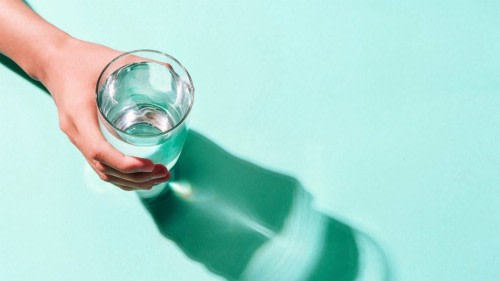We all know how important water is for our daily function, which means it becomes even more critical to hydrate and restore our water supplies before, during and after exercise.
As water is essential to regulate our body temperature, support muscle movements and maintain blood volume, the ability to perform all of these functions during exercise relies on adequate fluid intake.
More importantly, it is vital that we replenish the loss of water that takes place when we sweat during physical exertion, which is how the body removes heat when beads of sweat evaporate on the surface of our skin.
A higher intensity or prolonged workout will result in greater levels of fluid loss through sweating, therefore we must ensure that we are rehydrating through the intake of water. Without doing this successfully, the body will dehydrate leading to a number of physical effects.
Indications of Dehydration
Contrary to popular belief, thirst is not actually the best indicator that you need to drink. Typically, it means that you are most likely already dehydrated.
According to Healthy Water Technologies Australia, the most common signs of dehydration include:
- Chills
- Clammy skin
- Elevated heart rate
- Nausea
- Headache
- Dizziness
- Shortness of breath
- Dry mouth
Upon experiencing these symptoms, you need to get water into your system as soon as possible. Without appropriately replenishing your body fluid, dehydration often leads to:
- Heat exhaustion
- Heat stroke
- Muscle cramping/fatigue
- Breakdown of skeletal muscle
One of the most common tests to see whether you are dehydrated or not is to check the colour of your urine. If you see that it pale and clear, then you’re well-hydrated. However, if it’s darker in colour that means your body requires more fluid.
Why You Need To Rehydrate
If you don’t rehydrate during physical activity, your ability to perform will be diminished. In fact, according to the Victorian Government’s Better Health Channel, “a loss of fluid equal to two per cent of body mass (for example a 1.4 kg loss in a 70 kg person) is enough to cause a detectable decrease in performance.”
A loss even greater than two per cent could potentially lead to severe physical effects including nausea, vomiting, diarrhoea and other gastro-intestinal problems.
It’s important to understand that the more you sweat during exercise, the more fluid you will need to consume afterwards. To help alleviate this, it’s best to consume water before, during and then after exercise so that you are not trying to replace it all at once.
There is also the possibility of consuming too much liquid at the one time, known as over-hydration, and although incredibly rare, could even lead to a case of hyponatremia which results in death.
Tips For Staying Well Hydrated
There are a range of things you can do to ensure that you remain well hydrated during exercise. According to Sports Dieticians Australia, here are some of the most effective tips:
- Always start exercise well hydrated; this will lower the risk of becoming dehydrated.
- Develop a plan for drinking during exercise based on your own sweat rates.
- Immediately after exercise, monitor your weight change to estimate your final fluid deficit.
- During recovery, you will continue to lose fluids through sweating and urine losses, so plan to replace 125-150% of this fluid deficit over the next 2-6 hours. For example, if you lost 1 kg (1000mL), you will need to drink 1250-1500mL to fully re-hydrate.
- Drink fluids with your recovery snacks and the following meal to achieve this goal.
Most importantly, be well prepared. Make sure that you take a large water bottle with you whenever you exercise, or you at least have access to water through a tap/fountain wherever you are.
In addition, make the most of your breaks or scheduled ‘sips’ to ensure you are consuming enough fluids during your workout. There are both free and paid hydration reminder apps you could even use to assist you.
Water vs Sports Drinks vs Other Liquids
A common question within this topic is whether water is the best fluid to consume for rehydration purposes, and most of the time the answer is yes.
Water:
Not only is water the easiest fluid to access and is completely free, but it also has a number of health benefits including the fact is contains no kilojoules, but does contain fluoride which is good for your teeth.
It’s often the best fluid replacement for low-intensity and short duration exercise, but there may be alternatives for high-intensity or endurance training.
Sports Drinks:
If you require additional replenishment on top of just body fluids, then sports drinks can act as a good option to provide the required carbohydrates and electrolytes that will restore energy sources.
Therefore, if you are completing a high-intensity workout or a prolonged endurance session, sports drinks may be useful alternative to water. It is important to note however, sports drinks do contain high levels of sugar and should not be consumed in large amounts.
Other Liquids:
As Better Health alludes to, you should also look to consume natural fruits and vegetables that contain high amounts of water such as orange, watermelon, cantaloupe and pineapple, as well as cucumber, zucchini, tomato and lettuce.
There are other liquids that some athletes choose to consume during or after exercise. Caffeine is one and was recently removed as a banned substance by the World Anti-Doping Agency.
Caffeine is known to provide a quick energy burst, sustain performance for short periods of time and reduce the perception of effort. However, it is not recommended for general exercise as there are other potential detrimental side effects.
Another fluid consumed after exercise (particularly in local sports establishments) is alcohol. It’s important to know that alcohol DOES NOT replenish fluids and is not a suitable alternative to water. In fact, it has the complete opposite effect as it will lead to dehydration and impair an athlete’s ability to recover properly.
Understanding the importance of hydration before, during and after exercise, in particularly the consumption of water, will help you perform at a higher level, replenish fluid loss and recover properly after a workout.









